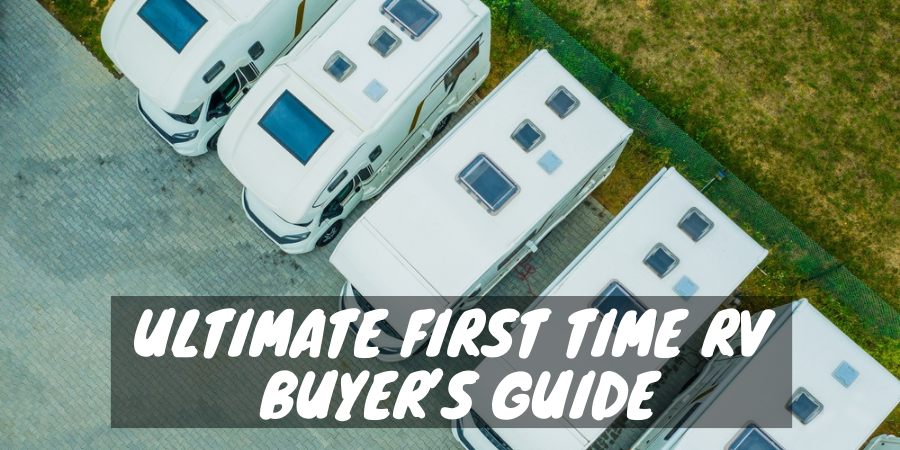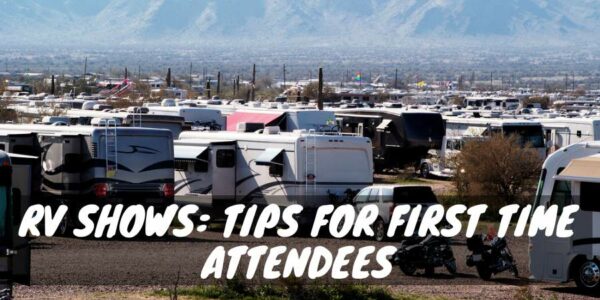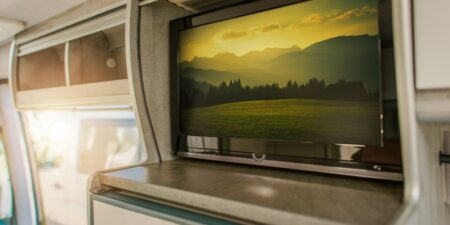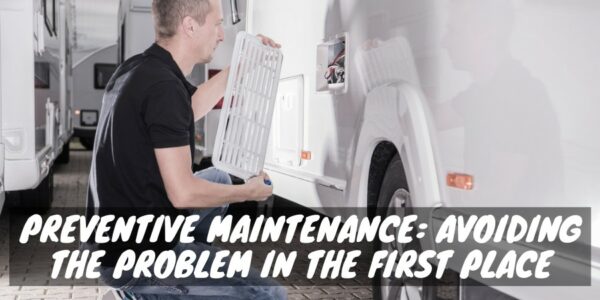Do you wish there’s a way to buy your first RV without all the uncertainty your making the best decision?
RVs are a massive investment, and the last thing you want to do is make mistakes that cost you money or leave you unhappy with your camper selection.
To help you avoid such a dilemma, I put together this buyer’s guide for a first time RV purchase that brings together critical information on:
- The different camper types
- Avoiding new-buyer mistakes
- Tips for buying a travel trailer
- Tips for buying a motorhome
- Whether you should buy new or used
The information in this RV buying guide will give you the inside scoop from current recreational vehicle owners about all the things that make or break a good RV purchase so you can shop with confidence!
Quick Breakdown of RV Types
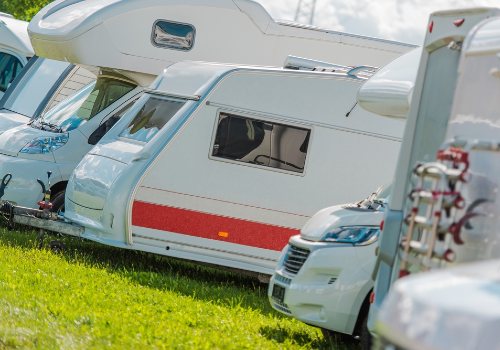
Before you shop, you need to understand all the different recreational vehicle types.
There are numerous models and floorplans from all the various RV brands from which to select. The buying process can quickly get overwhelming if you don’t first decide what type of RV you prefer.
TEARDROP TRAILER – A small aerodynamic travel trailer that’s easy to pull by many automobiles and SUVs and is a nice upgrade over tent camping.
POP-UP CAMPER – Also known as a foldable, fold-down, or tent-trailer. These RVs retract into a flat box for easy towing but open to allow sleeping accommodations for up to six people.
TRUCK CAMPERS – These sit in the bed of a truck for travel and camping or can be set on the ground so you can use the truck for local sightseeing. These campers are surprisingly roomy and efficient.
TRAVEL TRAILERS – These trailers hitch to the bumper of a tow vehicle. Most models range in length from 12-35 feet. Travel trailers are generally lightweight and have lower ceiling height.
TOY-HAULER – A travel trailer or fifth-wheel with a large door in the back that drops down to create a ramp. This feature allows you to load an ATV, kayaks, motorcycle, or other “toys” for outdoor fun.
FIFTH-WHEEL – A large travel trailer that uses a gooseneck hitch that attaches to the bed of a heavy-duty truck. Fifth-wheels feel very spacious because the ceilings are higher.
CLASS A MOTORHOME – This large motorhome (often called a motorcoach, bus, or diesel-pusher) has a flat front end and lots of interior space. Many are 40-45 feet long and often are the most high-end camper you can purchase.
CLASS B MOTORHOME – These motorhomes (also called a conversion van or campervan) range from 18 to 24 feet. Built on a cargo van chassis, they remain compact and easy to drive.
CLASS B+ MOTORHOME – A step up in size from the standard Class B, this motorhome provides a bit more space and amenities, such as a shower, and has an outward appearance of a small Class C.
CLASS C MOTORHOME – Class C motorhomes range in length from 18-41 feet and include ample beds, kitchens, bathrooms, and more. The front end has the cab, with an overhang above it.
Mistakes to Avoid When Buying Your First RV
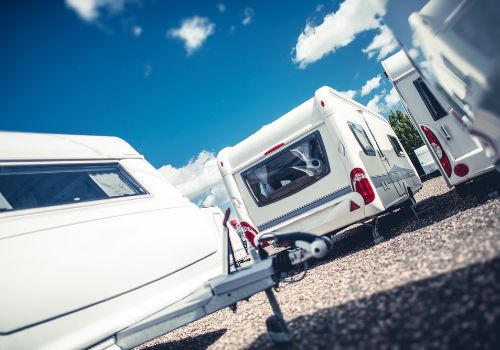
What you need to know before buying an RV starts with pointing out the poor decisions many new RV shoppers make so you won’t make them yourself.
Here are the top RV-buying mistakes and what you need to consider instead.
Jumping in With No RVing Experience
Just because you like the “idea” of RVing or camping, it doesn’t mean you should go buy a camper when you have no experience with them.
By experience, I don’t mean you took some RV vacations with your family as a kid and remember having a great time. I mean, have you driven a motorhome for hundreds of miles?
Have you pulled a long travel trailer through a tight campground and backed it into a campsite in the dark?
Please don’t buy a camper unless you have a basic understanding of how they drive, park, and operate, along with getting a taste of what RV campgrounds are all about.
The best way to learn whether RVing is for you is to rent or borrow a camper and try it. The money you’ll pay to rent will be much less than the $25,000-$60,000 average price of an RV if you decide it’s not for you.
Not Thinking About How and Where You Like to Camp
I see many new RVers trading in their camper after a year for a different type because it didn’t work for their camping lifestyle.
Some people fall in love with the room and amenities in a 40-foot motorhome but then realize they can’t fit into most national and state park campgrounds, so they downsize for a mid-size model.
Some people go for a compact travel trailer or Class B but then realize that minimalism is not for them and upgrade to a trailer with a kitchen and more storage space.
Before you ever step foot in an RV dealership, make a list of:
- Where you expect to camp most and what type of RV can make it happen
- What level of comfort or luxury you need
- What amenities are must-haves
This list will quickly eliminate many RV types that won’t fit your needs, so you can spend more time comparing the ones that do.
Looking at Features Over Function
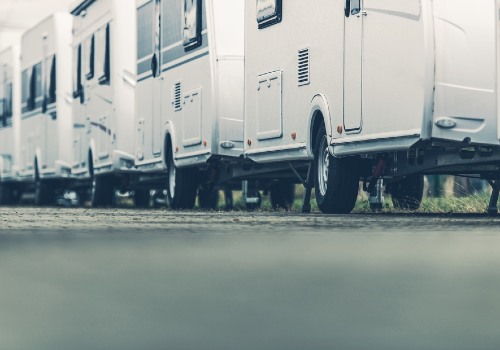
New RVs are clean, shiny, and are full of modern design elements that are very attractive to buyers.
Dealership showroom RVs are also devoid of camping gear, food, clothes, shoes, pets, and other people that fill up a camper’s space.
A kitchen island in a travel trailer may entice you, but take the time to stand there and pretend to wash the dishes or prep food. Does it function comfortably?
Remember to “test camp” the features and layout while shopping for a new RV. Always bring your entire camping crew along to see how you’ll fit inside to help you avoid a purchasing disaster.
Rushing the Process
Don’t buy a camper for the here and now as your needs may change.
You might plan to have kids. You could be becoming empty-nesters, get a dog, or plan to work remotely and RV full-time.
Think ahead three, five, or ten years to what you may need or want. Taking a few moments to consider future possibilities allows you to find a camper that works now and will fit into your changing plans.
Paying Way More Than You Should
How much below MSRP can you buy an RV? It depends on the season, what model you choose, and dealer incentives.
Most dealers mark up RVs 30-35% over invoice so they have plenty of room to negotiate.
The best way to snag the most significant deals is to buy during the last day of an RV show. Sellers would rather you take that camper home instead of taking it back to the dealer.
I’ve seen RV sales price slashed by tens of thousands off MSRP at these shows, so wait and check them out when one comes to a town near you.
Not Taking Into Consideration Total RV Expenditure
The lowest RV sales price may fit your budget, but you’ll have other expenses that go along with RV ownership like:
- Fuel costs
- Insurance
- Maintenance
- Storage
- Campground fees
- RV memberships
A motorhome will have a large fuel expense that you need to set aside for camping trips. A travel trailer will cause drag on your tow vehicle lowering its normal gas mileage, and also increase wear and tear.
You may need to pay $50-$200 monthly for RV storage, around $120 a month for insurance, $50 average a night for campground fees, and $40-100 yearly for handy RV memberships like Good Sam.
Maintenance on an RV is never-ending, and services like oil changes and new tires will be higher than cars, so be ready for it.
Tips for First-Time Travel Trailer Buyers
Make Sure Your Vehicle Can Safely Tow What You Buy
Before you shop for a travel trailer, know your tow vehicle’s rating so you’ll know what size trailer you can pull.
Take the time to understand all the terms pertaining to towing, such as UVW, GVWR, CCC, GCWR, and hitch weight so you won’t let a pushy salesperson talk you into a travel trailer that is too heavy.
Many sellers like only to quote the UVW, or dry weight, of the trailer to make it sound lighter than it actually will be when you load it for a camping trip. Ask for manufacturer paperwork to see all the numbers for yourself.
Don’t Forget the Accessories
Many travel trailers don’t come with essential features, such as trailer brakes, tire pressure monitors, sway bars, or backup cameras.
Add these to increase safety and help make parking at campsites easier, but expect them to set you back $500-$1,000.
Want to Connect With a Community of Over 1,078 RV Enthusiasts?
You’ll also need chocks for the wheels and stabilizing jacks if they don’t come with the trailer.
Tips for First-Time Motorhome Buyers
Mid-Size Provides the Most Camping Flexibility
A motorhome in the 24 to 28-foot range will give you enough interior space yet fit into just about any campsite across the US without issue. Look for a model with slides if you want even more room.
Consider a Toad
Driving a motorhome to a campground is great, but if you plan to sightsee or run into town for groceries, do you really want to pack everything away and take the RV?
Many motorhome owners buy a model with a tow-capacity for a small car, which RVers refer to as a “toad.” A toad provides freedom of movement once you reach your camping destination, especially if riding a bicycle is impractical.
Don’t Overlook Driving and Cab Area Comfort
You may be driving your motorhome thousands of miles over the years, so driving comfort is critical. A short test-drive isn’t going to highlight any potential issues, so try to make it more extensive if possible.
Have all people who may drive the motorhome test it out and sit passenger-side and perform general tasks to ensure that things feel comfortable.
Cab seats that swivel backward are another great feature that increases seating in the living space.
First-Time Buyer Tips for Any Type of Recreational Vehicle
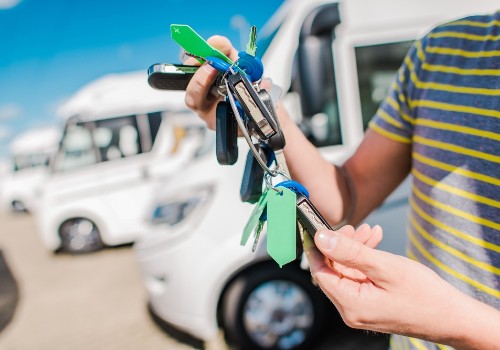
Ask About RV Features You Don’t See
If your camper has a shower, is the hot water tank endless or only 6 gallons? From years of RVing experience, I can attest that a 6-gallon water heater means a five-minute hot shower, tops.
What about the wastewater and freshwater tank size? If you only camp at RV parks, then the size of your tanks doesn’t matter as you’ll have unlimited access to sewer drains and freshwater.
A 20-gallon black tank can fill in only 3-4 days. For people who love to dry camp, this size can be problematic for week-long vacations. A 40-gallon freshwater tank will limit showers or dish washing.
The size of propane tanks and the house battery bank are other features you may forget to ask about when touring a recreational vehicle. Still, they make a significant impact on your camping experience.
Ask for specifics about how long lights will run off battery power or how often you’ll need to fill propane tanks if you cook or heat your camper.
New or Used RV – Which is Better?
Used RV Pros and Cons
Pros:
- All the typical new-RV issues are fixed
- Lower price and usually more room for negotiation
- Essential gear often come with it like stabilizers, chocks, levelling blocks, surge protector, sewer kits, hoses, outdoor rugs, camp chairs, etc.
Cons:
- Finding a specific model or floorplan may take months
- You need to trust the seller isn’t hiding major defects or leak damage
- May be out of warranty
- Tires are usually at end-of-life (replacement can cost $1K+)
Is there a Kelley Blue Book for travel trailers and RVs to make shopping for a used camper easier?
No, but the NADA RV Guide is the best alternative to locate a value if you know a camper’s specifics. The range of camper types, models, and features is so vast that the guide will only provide a ballpark figure.
New RV Pros and Cons
Pros:
- More models, floorplans, and options to choose from
- Most come with a warranty
- You can set up RV financing
- You don’t have worry of hidden damage or wear and tear
- Current engineering and design improve fuel economy, comfort, and function
Cons:
- Loses up to 20% of value once you drive it off the lot
- You’ll likely spend $ and time at the repair shop working out the “bugs”
- New RVs are expensive
Final Thoughts
With so many camper brands, models, and options available, shopping for a new or used RV can seem very daunting for a first-time buyer.
By using this guide, you’ll be able to make a better initial RV purchase that fits your camping style and saves you money and frustration.
When you buy the right RV or travel trailer the first time, you can hit the road and start making wonderful camping memories for years to come!
First Time RV Buyers
"Man cannot discover new oceans unless he has the courage to lose sight of the shore."
-- Andre Gide

